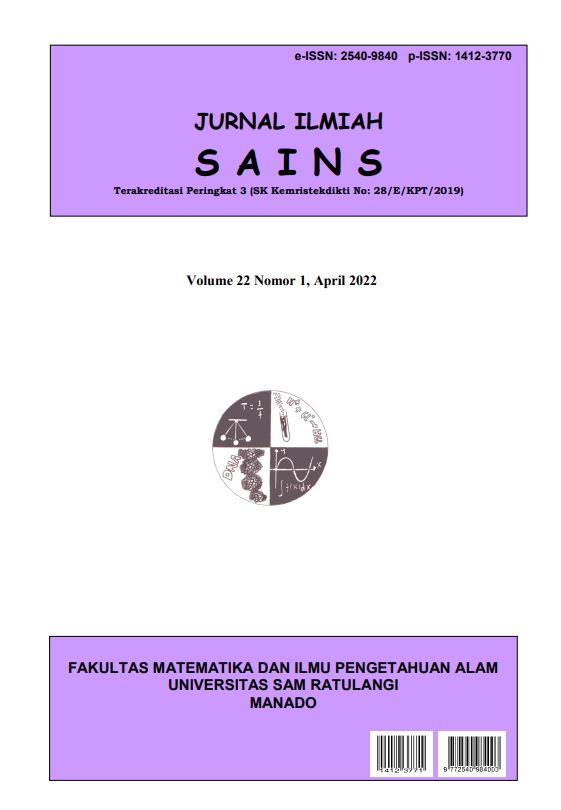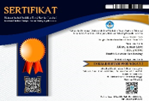Kepadatan Populasi Cacing Tanah pada Perkebunan Kelapa Sawit di Desa Salang Tungir Kecamatan Namorambe
DOI:
https://doi.org/10.35799/jis.v22i1.35703Abstract
Penelitian ini bertujuan untuk menganalisis kepadatan populasi cacing tanah di perkebunan kelapa sawit dengan perbedaannya pada strata umur kelapa sawit di Desa Salang Tungir Kecamatan Namorambe.Metode yang digunakan adalah metode survey dengan teknik pengambilan sampel cacing tanah secara hand sorting pada stasiun I (TBM) dan stasiun II (TM). Analisis data untuk kepadatan hingga indeks nilai penting cacing tanah digunakan rumus tertentu, dan untuk perbedaan kepadatan digunakan uji T. Hasil penelitian menunjukkan bahwa cacing tanah di perkebunan kelapa sawit TBM terdapat 3 jenis: Pontoscolex corethrurus, Pheretina sp., dan Lumbricus. Kepadatan relatif dan indeks nilai penting yang tertinggi ditemukan pada Pheretina sp. yaitu 36,09% dan 69,42%. Sedangkan pada TMterdapat 4 jenis: Pontoscolex corethrurus, Pheretina sp., Lumbricus, dan Microscolex. Kepadatan relatif dan indeks nilai pentingnya ditemukan pada Pontoscolex corethrurus yaitu secara berurut 30,56% dan 55,63%. Nilai kepadatan cacing tanah ditemukan lebih tinggi pada perkebunan kelapa sawit yang berumur 4 tahun.
Kata kunci: Cacing tanah; Elaeis quineensis Jacq; kepadatan
Â
Earthworm Population Density in Oil Palm Plantation in
Salang Tungir Village, Namorambe District
 ABSTRACT
This study aims to analyze the population density of earthworms in oil palm plantations with the differences in the age strata of oil palm in Salang Tungir Village, Namorambe District. The method used is survey method with earthworm sampling technique by hand sorting at station I (TBM) and station II (TM). Analysis of data for density to index of significance of earthworms used a certain formula, and for differences in density used the T test. The results showed that there are 3 types of earthworms in TBM oil palm plantations: Pontoscolex corethrurus, Pheretina sp., and Lumbricus. The highest relative density and significant value index were found in Pheretina sp, namely 36.09% and 69.42%, respectively. While in TM there are 4 types: Pontoscolex corethrurus, Pheretina sp., Lumbricus, and Microscolex. The relative density and significance index found in Pontoscolex corethrurus were 30.56% and 55.63%, respectively. Earthworm density values were found to be higher in oil palm plantations aged 4 years.
Keywords: Earthworm; Elaeis quineensis Jacq; density
References
Darmi, D. Yardiansyah, & Rizwar. 2013. Populasi Cacing Tanah Megadrili di lahan Perkebunan Kelapa Sawit dengan Strata Umur Tegakan yang Berbeda. Prosiding Semirata FMIPA Universitas Lampung, 167-172.
Deibert, E.J., & Utter, R.A. 1994. Earthworm Populations Related to Soil and Fertilizer Management Practices. Better Crops/Summer, 78(3): 9-11.
Falco, LB., Sandler, R.V., Momo, F., Di Ciocco, C.A. & Saravia, R.L, & Coviella, C. 2015. Earthworm assemblages in differentintensity of agricultural uses and theirrelation to edaphic variables. Peer J 3:e979: 1-18.
Hanafiah, K.A., Napoleon, A. & Ghoar, N. 2010. Biologi tanah: ekologi dan mikrobiologi tanah. PT. Raja Grafindo Persada, Jakarta.
Kalu, S., Koirala, M. & Khadaka, U.R. 2015. Earthworm population in relation to different land use and soil characteristics. Journal of Ecology and the Natural Environmen, 7(5): 124-131.
Lemtiri, A., Colinet, G., Alabi, T., Cluzeau, D., Zirbes, L., Haubruge, E. & Francis, F. 2014. Impacts of earthworms on soil components and dynamics. A review. Biotechnol. Agron. Soc. Environ.,18(1): 121-133.
Luthfiyah, H. 2014. Keanekaragaman dan kepadatan cacing tanah di Perkebunan Teh PTPN XII Bantaran Blitar [Skripsi]. Fakultas Sains dan Teknologi, Universitas Islam Negeri Maulana Malik Ibrahim Malang.
Potapov, A., Schaefer, I., Jochum, M., Widyastuti, R., Eisenhauer, N. & Scheu, S. 2021. Oil Palm and Rubber Expansion Facilitates Earthworm Invasion in Indonesia. Biol Invasions, 23: 2783–2795.
Qudratullah, H., Setyawati, T.R. & Yanti, A.H. 2013. Keanekaragaman cacing tanah pada tiga tipe habitat di kecamatan Pontianak kota. Jurnal Protobiont, 2(2): 56-62.
Senthil, V. & Sivakami, R. 2018. An Analysis of the Biodiversity of Earthworms in Three Locations around Tiruchirappalli, Tamil Nadu, India. Int. J. Curr. Microbiol. App. Sci, 7(9): 3195-3199.
Siregar, D.A., Sitinjak, R.R., Afrianti, S. & Agustina, N.A. 2021. Analisis Vegetasi Gulma pada Perkebunan Kelapa Sawit (Elaeis quineensis Jacq.) di Desa Salang Tungir, Namorambe, Deli Serdang. Jurnal Bios Logos, 11(2): 129-133.
Sitinjak, R.R., Suratni A. & Nur Agung, S. 2018. Keanekaragaman Tumbuhan pada Perkebunan Kelapa Sawit (Elaeis guineensis Jacq.) di Sekitar Pesisir Pantai Cermin Kabupaten Serdang Bedagai. Agroprimatech, 1(2): 91-99.
Sitinjak R.R., Harmileni, & Supriyadi. 2021. Keanekaragaman Jamur pada Pohon Kelapa Sawit di Pesisir Pantai Pt. Mopoli Raya Unit Damar Condong Kab. Langkat Sumatera Utara. Pelita Kota, 2(2): 78-87.
Sudarso, N., & Khoiri, M. A. 2015. Pemberian Zat Pengatur Tumbuhan (ZPT) Alami Pada Bibit Kelapa Sawit (Elaeis guineensis Jacq.) di Main Nursery. Jom Faperta, 2(2) : 1-7.
Sucipta, N.K.S.P., Kartini, N.L. & Soniari, N.N. 2015. Pengaruh populasi cacing tanah dan jenis media terhadap kualitas pupuk organik. E-jurnal Agroteknologi Tropika, 4(3): 213-223.
Turnip., L. & Arico, Z. 2019. Studi Analisis Vegetasi Gulma pada Perkebunan Kelapa Sawit (Elaeis guineensis Jacq.) di Unit Usaha Marihat Pusat Penelitian Kelapa Sawit Kabupaten Simalungun Sumatera Utara. Jurnal Biologica Samudra, 1(1): 64-73.







